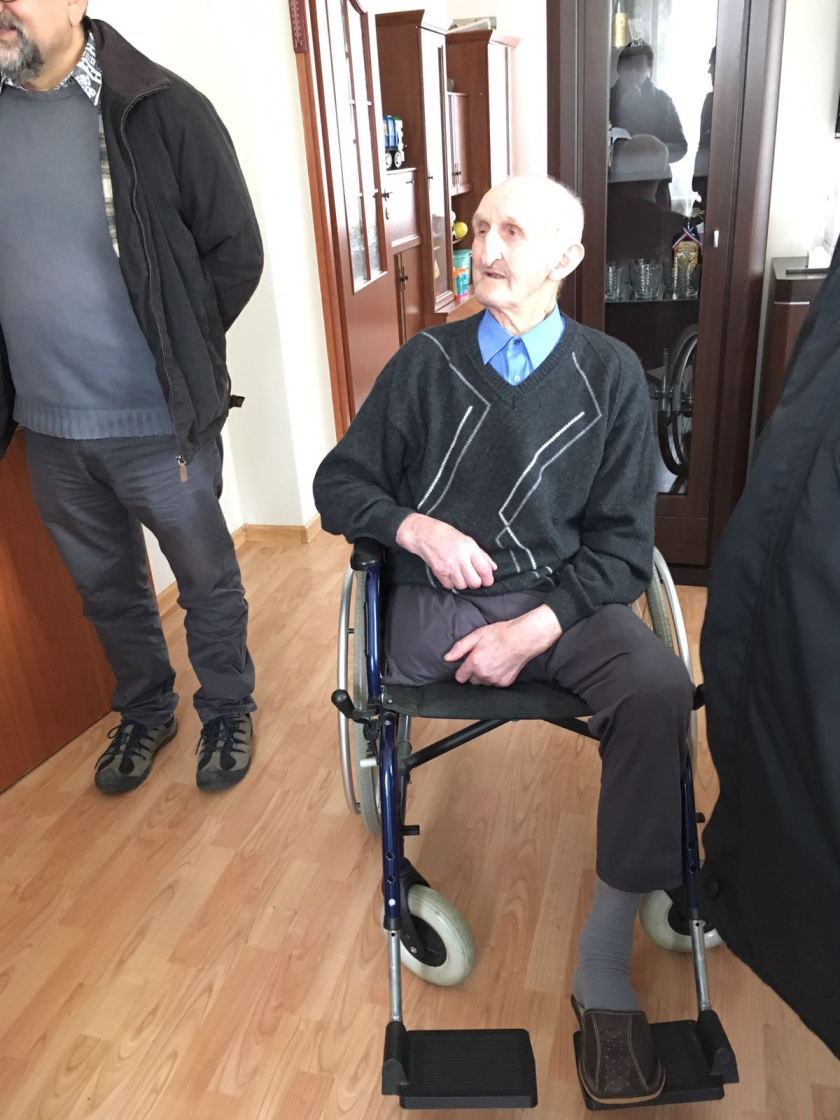
We turned left onto a dirt road and saw the now familiar sign – Bagatele. The car, driven by our new-found cousin, Marta Lis, did not travel much farther – a mere half block. We turned into a gravel drive-way of sorts and parked. Marta pointed, to lot next door, and said: “that is where my great-grandfather, Mottl Goldberg lived.”
We traveled to meet Mr. Mieczyslaw Zaleski, a 94-year old man – the oldest living person in Bagatele. Here to make the introduction was the shadchan himself – Father Rafal Figiel. As we opened the car door, there was Father Figiel waiting to greet us. He wore blue jeans and a blue button down checkered shirt – not what I expected. We greeted each other as long lost friends. Our smiles and hugs made up for the lack of a shared language. I used my best Polish, made strong eye contact and said – Dziekuje Ci – thank you (pronounced Jenkuya). It was the best I could do to attempt to express my deep thanks to him.
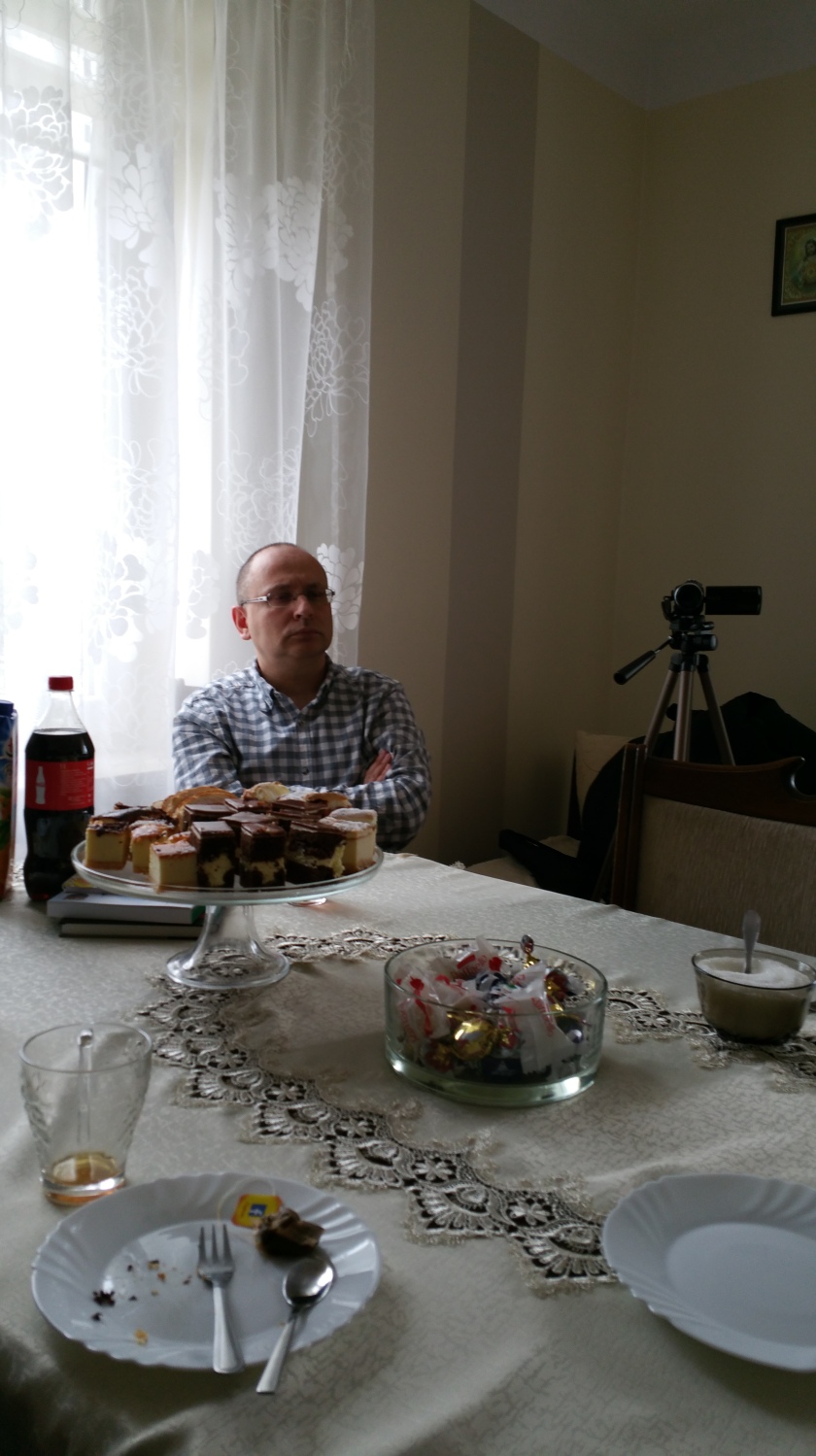 (Father Rafal Figiel)
(Father Rafal Figiel)
We entered the house and met Mr. Zaleski, his daughter and some of his grandchildren – all of whom live in the home. Mr. Zaleski had one of his legs amputated a year ago and sits in a wheelchair. His grey pants were pinned up on his amputated leg, so that it would not flap around. He looked old, but very smart in a blue shirt buttoned up to the top, with a grey sweater. Marta served as translator and did an outstanding job considering that Mr. Zaleski jumped from topic to topic and did not stop talking to give Marta a chance to breath or translate all that he was saying. Esther took notes, so I hope to piece it all together.
Mr. Zaleski had a lot to say. Father Figiel, on Mr. Zaleski’s instruction, drew a map of the homes of the families who lived in Bagatele before the war. Mottl Goldberg lived next door to the Zaleskis, just next to where we were sitting. Mottl, who had a small farm and traded animals, was tall, stout and not wealthy. Zelig Goldberg *(Sam’s father), his cousin, lived at the other end of town. Zelig was a short, energetic man with a strong build. He had short hair and sported Peyes (sidelocks). On weekdays he wore work clothes, but on Shabbes, he wore a long black Kapote. Mr. Zaleski did not remember Zelig wearing a hat, but he recalled that he wore a Kippa (skull cap) on the top, back of his head. He described how the Jews would pray with the leather straps on their arm and head. He was describing Tefillin (phylacteries) worn when praying on weekdays, but not on Shabbes. My daughter, Esther had a picture of Shlomo wearing a Talis (prayer shawl) and Tefilling. She pulled it up on her phone and showed it to Mr. Zaleski. He exclaimed: “tac, tac, tac (yes, yes, yes).”
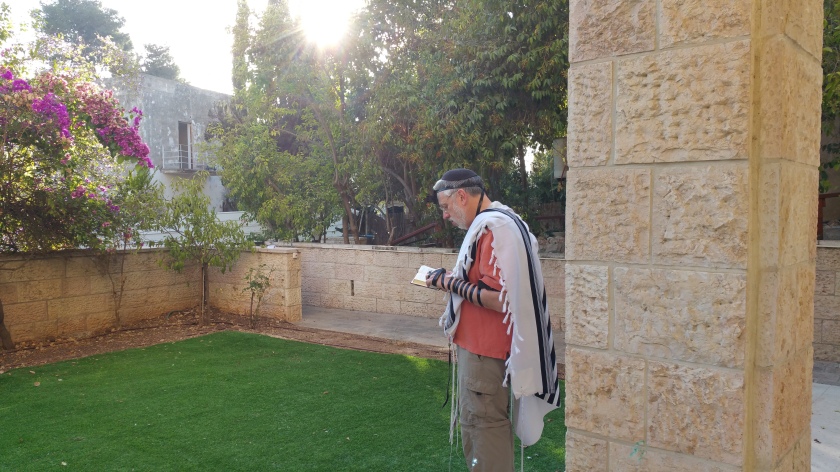
This seems to be a memory that sticks. Idul (Yusif) Lis, with whom we visited later that day, said as a boy of 6 when the war started, he did not have many memories of home. But a few memories stayed with him: gefilta fish; cholent, his grandparents; and men wearing Tefilin. Esther showed Idul the same photo of Shlomo that she had shown to Mr. Zaleski just a few hours earlier. He said the same thing: “tac, tac, tac,” shaking his head yes, as the memory of a man wearing Talis and Tefilin flooded his mind.
In contrast to Mottl, Zelig was a wealthy man. He had a large farm and traded in animals (mostly cows). He mentioned that Zelig worked with the Polish army. The army had a large presence in the Ostrow area. Zelig provided them cows for meat. Recently, my husband, Shlomo told me that whenever Sam would speak of his father’s wealth, his mother, Esther, would chime in and say – “oh yes, Rockafella from Bagatella.”
Though the Jews and Non-Jews of Bagatele stayed mostly separate, socially, Mr. Zaleski remembers Zelig and Faiga well. Faiga was a short, beautiful woman. She was quiet and took care of the chickens and the ducks. He also remembers the Goldberg children. He recalled that Hersh Meyer was married and had five children. They lived in a house across the dirt road from Zelig and Faiga. He confirmed that Hersh’s family shared the building with the Goldberg cows and worked on the farm and in trade with his father. Hersh was also a Shoichet (ritual slaughterer). Itche was married as well, and lived just a few houses down from his parents in a home they rented from the Kazimierczyu family. Itche was also a trader. Five houses down from where Itche lived, Idul (Yusef) Lis’s family had a home. Mr. Zaleski remembered Shmulik (Sam) well and said he lived with his parents. He spoke of one of Sam’s sisters as Bubke, but I could not confirm whether this was Raizel or Anya. But he mentioned that Bubke got married and moved to Russia. The name Lis was mentioned – it could be that Bubke married another member of the Lis family (perhaps a relative of Idul Lis). Mr. Zaleski recalls that after they got married, they went to Russia.
Father Figiel mentioned that the earliest census of Bagatele is from 1850 and it shows that the village had 15 families and farms. The 1850 list of families did not include any Goldbergs. So, the Goldbergs must have arrived in Bagatele sometime after 1850. But the date of their arrival is unknown.
Mr. Zaleski described the school systems. Polish public school went until 7th grade. For the first four years of school, the children went to Jasienica and the last three years were educated in Wonsewo (2 kilometers away). The school house in Wonsewo was just a home that was used as a school. Father Figiel explained that this house currently still stands. It is next to the Church and he lives in the top part of the house and uses the classrooms to teach Catholic students religious studies. We visited the “school house” and stood in the room that Sam likely sat in from grades five through seven.
Mr. Zaleski also described that the Mikve (Jewish ritual bath) was in Wonsewo. He explained that the men would go on Friday to bathe in the Mikve. Father Figiel showed me where it had been located. The Mikve building was made of wood and is no longer there. Idul Lis described his memory of the Mikve, where he would go with his father. His vague memory is of a small house. When you enter, you had to go down steps to the pool of water. The Mikve was lined with stones and the water was warm. Sam described how he and his father and brothers would stop work at 2 PM on Friday and all go to the Mikve together. I visualized Sam, his father and his brothers, walking down the road towards Wonsewo to bathe in the Mikve. I am pretty sure this road does not look terribly different than it did in the 1930’s.
The beginning of the war is etched in Mr. Zaleski’s memory. He retold the events with passion. I felt that he was talking about events that happened last week, not 78 years ago.
The Germans entered Bagatele on September 17, 1939, just 16 days after the start of the war. They stormed into town, after killing 500 Jews in the nearby city of Ostrow. The Germans chased the Jews of Wonsewo, just 2 kilometers away, into Bagatele. They came running in a panic with the Germans following them with their guns blazing. They created chaos forcing residents of the town to run this way and then that way. Mr. Zaleski, who was 16 at the time, was shot in the jaw by a Nazi. He was badly injured. The Germans allowed his mother to take him to a nearby hospital, but as he described – “only so long as I kept my hands up in the air.” He showed us where the bullet entered his face. He still suffers from this injury. In a now familiar tactic, the Germans burned down some homes – including Mr. Zaleski’s. The Nazis told the Jews of Bagatele to leave – they should go to the Soviet-controlled area of Poland.
This advice was heeded by many of the Jews of Bagatele. But the majority of Zelig Goldberg’s children had already left. Mr. Zaleski’s father was the Mayor of Bagatele before the war. Sam described that when the war began on September 1, 1939, Mr. Zaleski Sr. (the Mayor) told Zelig that the Germans were coming and would take his sons into the army and kill the Jews. Zelig did not want to leave, but he helped some his children, including Hersh Meyer pack up and head east, across the Molotov Ribbentrop line. They settled in Slonim.
Sam and his parents stayed put and invited the Zaleski family, now homeless, to move into their home. Zelig was glad to reciprocate with the favor. Sometime in the early 1930’s Zelig’s home had burned down and the Zaleski’s hosted the Goldberg family for a year and a half. Mr. Zaleski explained that it took that long to sort out the insurance payments and have a pre-made house moved to Bagatele and settled on their property.
After the initial German attack, Bagatele was quiet – for a bit. The Zaleski’s were living with the Goldbergs and they tried to go about their business. Zelig and Faiga had heard about the Nazi murders in Ostrow and other cities and towns. About a month after the initial attack in Bagatele, Zelig and Faiga made the decision that they would leave and cross to the Soviet side of the border. However, in contrast to the initial open border and easy passage for Jews to the Soviet side, the border was now harder to cross. Jews were routinely robbed, harassed or even killed on the way.
Zelig and Faiga decided to sell their belongings that they could not take with them. They began to pack up boxes of the things that they wanted to take. They did not sell their home or their farm, as they certainly hoped to return. The boxes were in the house, ready to go. They were waiting for Shmulik (Sam) to come back from the Soviet side [he likely had gone to bring provisions to his siblings in Slonim]. As soon as Shmulik would come home, they would leave. Since they had sold their horse and buggy, the plan was to pack their boxes onto the Zaleski’s buggy and Mrs. Zaleski – whose first name was Stanislawa – would ride the buggy with Faiga and Shmulik and Zelig would walk at a distance so as not to attract attention from the Germans or Polish neighbors who might try to rob them.
One day, two Nazi officers showed up on Zelig’s farm and demanded that they give them a pig. Faiga saw the Nazis and moved some of the packed boxes into the rooms occupied by the Zaleskis – so that they can say they belong to them. She was fearful that the Nazis would steal their belongings. Meanwhile, Zelig explained to the Germans that he has no pigs. He is a Jew. Upon hearing this, the Nazis began to beat him and took out a knife and cut his arm. Mrs. Zaleski stepped in and said: “I have a pig, take one of mine.”
The Nazis stopped beating Zelig and entered the house and saw all the boxes. Zelig explained that they were leaving. Mrs. Zaleski stepped in and explained that many of the boxes belonged to her as they were temporarily staying with Goldbergs. The Nazis were satisfied to hear that the Goldbergs were leaving and left.
Mr. Zaleski explained that Shmulik came home that evening and they prepared to leave as soon as possible. [Note – Sam describes that the Nazi officers came to his home and told them to leave. So, in contrast to Mr. Zaleski’s recollection, I believe that Sam was home at this time.]
They packed their boxes in the Zaleski buggy and covered them with hay. They did not want to look conspicuous traveling on the road. So, Shmulik went a bit ahead of the buggy and Zelig took a rake and carried it over his shoulder – appearing as if he was simply heading out to the farm to do some work. Mrs. Zaleski rode in the buggy with Faiga and the 16 year-old Mr. Zaleski, just back from the hospital and with a bandaged head, led the horse out of town. They went through the forest and then a large field. They continued in this fashion until they reached Jelonki – very close to the border. They unpacked all their boxes into someone’s barn [I presume it was a friend of Zelig’s]. Their plan was to cross the border and then come back for the packages once they had a place to stay.
The Zaleskis helped them unload the wagon and said their goodbyes. They went back to the Goldberg home and remained there. He describes that the Germans appointed Mr. Zaremba as the head of their territory. Under German control, non-Jews, whose homes were burnt down, were allowed to “purchase” the property of the Jews who had fled. The Zaleskis “purchased” the Goldberg home. Mr. Crispin (not sure of spelling here) “purchased” the farm. The Zaleskis continued to live in the Goldberg home for two winters until their home was rebuilt.
Thus ends the information shared by Mr. Zaleski on Friday afternoon. I could not believe that I had just spoken to perhaps the only possible person I could have talked to who was an eye witness to what happened in Bagatele when the war started and specifically, someone living in Goldberg home during those first chaotic weeks of the war!
As I prepare to post this – I am sitting in the Warsaw airport about to board my plane. Today is Yom Hashoah and I use this day to yet again remember the pain and suffering of all those in the Holocaust. Those that survived and the millions that did not.
May their memories be blessed.
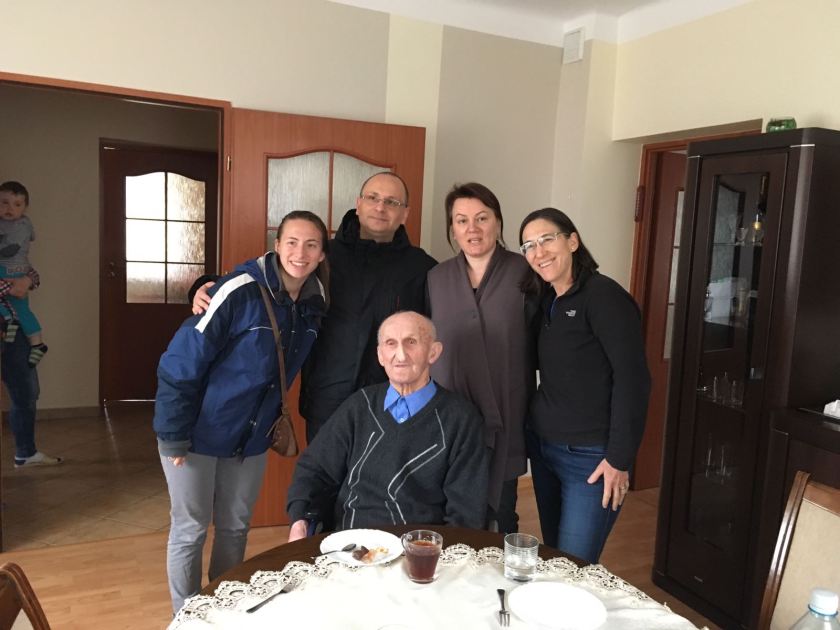 Picture from left to right: Esther, Father Figiel, Marta Lis, Karen Treiger, Mr. Zaleski.
Picture from left to right: Esther, Father Figiel, Marta Lis, Karen Treiger, Mr. Zaleski.
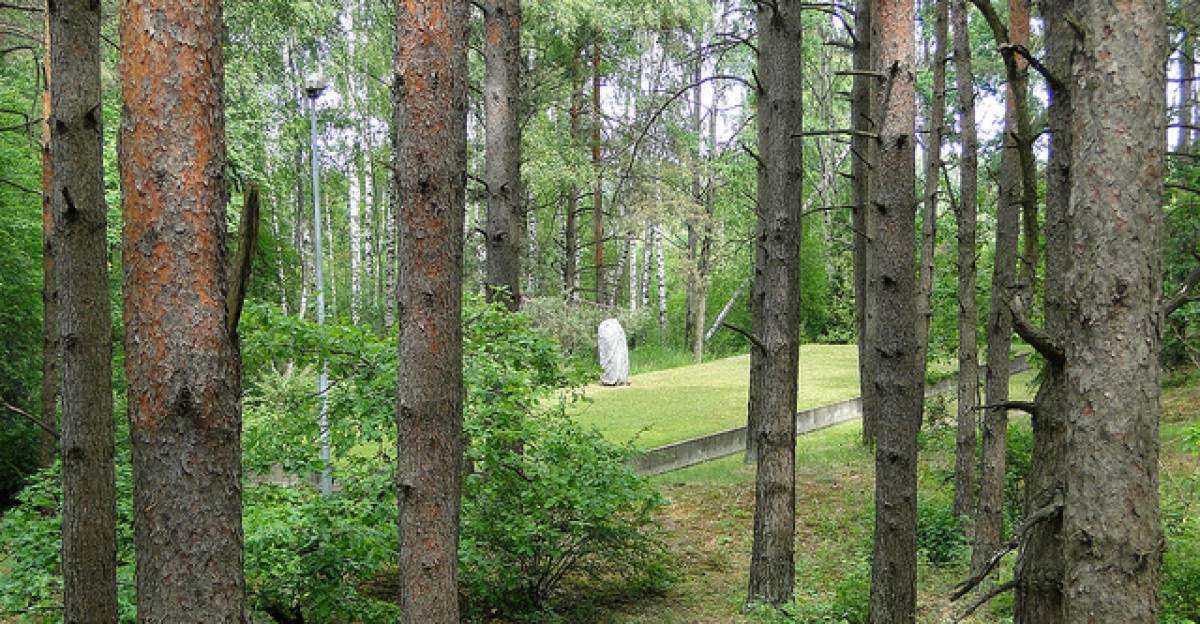


The Germans entered Bagatele on 8 September , 1939 🙂
LikeLike
My family was also from Bagatele. My mother’s uncle was the mayor at the end of the war, but was apparently executed by the Soviets in 1946. His name was Piotr Kazmierczyk.
LikeLike
That is amazing. Have you been back there?
LikeLike
Thanks for the correction. I thought Mr. Zaleski had said – 17th. Karen
LikeLike
I remember hearing de Tates story of Bagetella and the Germans. When he got “home” his parents had “sold” the farm and propeerty. His mother wanted to take a cow with them. The ‘buyer’ did not let her have a cow. De Tate
asked a German Soldier if they could have one of their cows and he said yes ‘let them take one”. It was not a Nazi , it was a plain soldier, there was a difference. I don’t remember where de Tate was coming from or who ‘bought’ the farm. Also after the war Shaya went back to the house and forceably took a bedspread/ tablecloth that he remembered from before the war in the house.
LikeLike